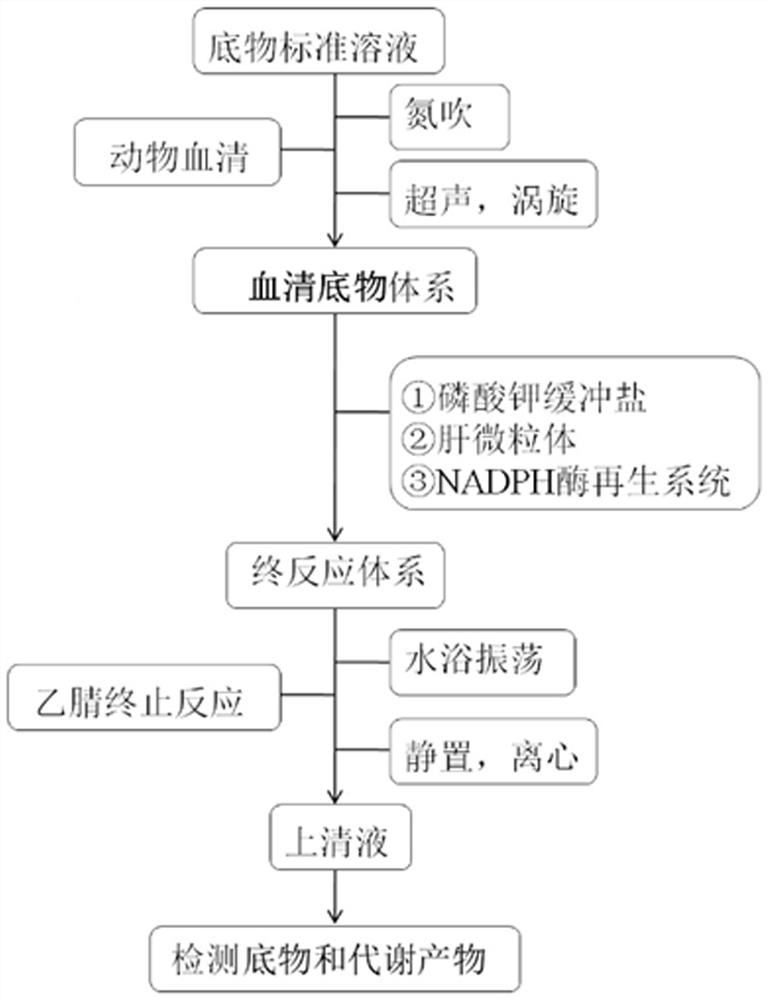Application of serum as reagent for dissolving halogenated organic pollutants in in-vitro liver microsome metabolism system
A technology for organic pollutants and liver microsomes, which is applied in the determination/inspection of microorganisms, biochemical equipment and methods, instruments, etc., to achieve the effect of simplifying operation steps, avoiding inhibition, and being suitable for large-scale operations
- Summary
- Abstract
- Description
- Claims
- Application Information
AI Technical Summary
Problems solved by technology
Method used
Image
Examples
Embodiment 1
[0041] In vitro metabolism of medium-chain chlorinated paraffins (MCCPs) by chicken liver microsomes: a comparative experiment between serum substrate systems and organic solvent substrate systems
[0042] (1) Serum substrate system: Take 200 μL of MCCPs standard solution (100 μg / mL, isooctane) in a 1.5 mL glass injection bottle, blow the organic solvent nitrogen to dryness with mild nitrogen, and then add 200 μL fetal bovine serum, sonicated for 20 min (ultrasonic frequency is 40KHz), vortexed to obtain the substrate solution dissolved in serum;
[0043]Acetonitrile substrate system: Take 200 μL of MCCPs standard solution (100 μg / mL, isooctane) into a 1.5 mL glass injection bottle, blow isooctane nitrogen to dryness with mild nitrogen, and then add 200 μL of acetonitrile , vortex to obtain the substrate solution dissolved in acetonitrile;
[0044] (2) Under ice bath conditions, take two 1.5 mL disposable centrifuge tubes, add 5 μL of the above two substrate solutions respect...
Embodiment 2
[0049] In vitro metabolism of triclosan by chicken liver microsomes: a comparative experiment between a serum substrate system and an organic solvent substrate system
[0050] (1) Serum substrate system: Take 10 μL of triclosan standard solution (100 μg / mL, methanol) in a 1.5 mL glass injection bottle, blow the organic solvent nitrogen to dryness with mild nitrogen, and then add 100 μL porcine serum, sonicated for 5 min, and vortexed to obtain a serum-dissolved substrate solution;
[0051] Methanol substrate system: take triclosan standard solution (100 μg / mL, methanol) as the methanol-dissolved substrate solution;
[0052] (2) Under ice bath conditions, take two 1.5 mL disposable centrifuge tubes, add 5 μL of the above two substrate solutions, and then add 455 μL potassium phosphate buffer solution (pH 7.4) and 12.5 μL chicken liver microsomes in turn. , 25 μL of Solution A, 5 uL of Solution B, shake well, and quickly place in a 40°C water bath for 30 min of shaking reaction...
Embodiment 3
[0056] In vitro metabolism of MCCPs by chicken liver microsomes: a comparative experiment between serum substrate system and organic solvent-serum substrate system
[0057] (1) Serum substrate system: Take 200 μL of MCCPs standard solution (100 μg / mL, isooctane) in a 1.5 mL glass injection bottle, blow the organic solvent nitrogen to dryness with mild nitrogen, and then add 200 μL chicken serum, sonicated for 20 min (ultrasonic frequency of 40KHz), vortexed to obtain serum-dissolved substrate solution; 1 μL of substrate solution was placed at the bottom of a 1.5 mL disposable centrifuge tube to obtain serum substrate system;
[0058] Acetonitrile-serum substrate system: Take 1 μL of MCCPs-acetonitrile solution and place it at the bottom of a 1.5 mL disposable centrifuge tube, add 1 μL chicken serum, vortex slightly, and let it stand at 4°C for 12 hours to equilibrate to obtain an acetonitrile-serum substrate system ;
[0059] (2) Under ice bath conditions, add 955 μL potassiu...
PUM
 Login to view more
Login to view more Abstract
Description
Claims
Application Information
 Login to view more
Login to view more - R&D Engineer
- R&D Manager
- IP Professional
- Industry Leading Data Capabilities
- Powerful AI technology
- Patent DNA Extraction
Browse by: Latest US Patents, China's latest patents, Technical Efficacy Thesaurus, Application Domain, Technology Topic.
© 2024 PatSnap. All rights reserved.Legal|Privacy policy|Modern Slavery Act Transparency Statement|Sitemap


